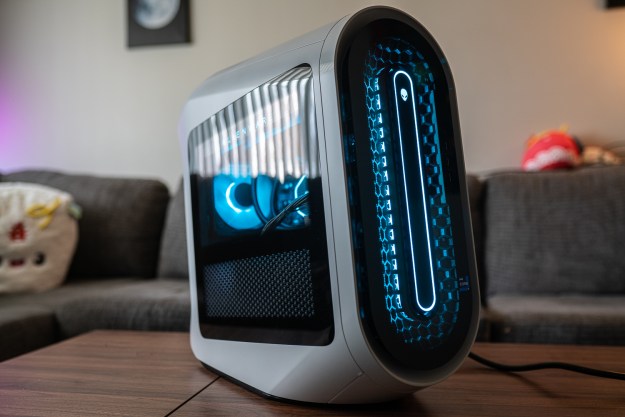It’s the question on everyone’s minds: Your PC can produce pretty decent audio without your having to spend a dime on new hardware, so why the heck are we advocating doing just that? Because you’ll get vastly superior quality using an optional add-on sound card—and it’s the only way to avoid compromised audio from Blu-ray movie discs. Following is everything you need to know about these handy accessories.
Don’t Compromise Blu-ray Audio
We’ll tackle the Blu-ray issue first, since it’s one many people aren’t aware of. A PC equipped with a Blu-ray drive is a compelling platform for watching Hollywood movies in high-definition (HD). There’s just one problem: Blu-ray discs are copy protected by AACS technology. The acronym stands for Advanced Access Content System, and it dictates that both the audio and video segments on commercially produced Blu-ray discs must be played back through what’s called a “protected path,” so that pirates can’t intercept the signals and make bit-perfect copies.
Most any video card operating under Windows can provide the protected path needed for the HD video side of the Blu-ray equation, but the computer industry never gave much thought to handling the audio side. As a result, the vast majority of today’s systems are incapable of playing back Blu-ray soundtracks at the highest fidelity that the format allows: Up to 7.1 channels at a sampling rate of 96kHz with 24-bit resolution, and up to 5.1 channels at a sampling rate of 192kHz with 24-bit resolution. If you think audio CDs sound great, consider that they’re encoded at a sampling rate of just 44.1kHz with only 16-bit resolution.
So what happens when you play a Blu-ray movie on a PC that doesn’t provide a protected audio path? You’ll still hear the soundtrack, but AACS rules dictate that the Blu-ray software player must down-sample that soundtrack to a 48kHz sampling rate with just 16-bit resolution.
Today, the only way to avoid the Blu-ray down-sampling compromise is to install an Asus Xonar HDAV1.3 sound card. There are two models available: The original Xonar HDAV1.3 ($185) and the Xonar HDAV1.3 Deluxe ($240). Both cards capture the HDMI output from your PC’s video card and re-encrypt the losslessly compressed HD audio (Dolby TrueHD or DTS-HD Master Audio, depending on the source disc) to provide the protected audio path that AACS requires. Both boards then output an HDMI signal that includes the soundtrack in its original sampling rate and resolution. The Deluxe version adds a video signal-processing chip and a daughterboard with eight analog audio outputs.

Left: Xonar HDAV1.3; Right: Xonar HDAV1.3 Deluxe
Auzentech has announced a similar product, the Auzentech Home Theater HD, which will be based on Creative’s excellent X-Fi audio chip, but that product has been delayed.
Sound Cards for Gaming
Game developers have been including surround-sound effects in their titles almost as long as Hollywood has, but you won’t hear them if you’re relying on your computer’s onboard audio solution. Creative has traditionally led the field in this market, licensing their EAX positional audio effects to game developers, who use the technology to create games that sound as good as they look. The latest incarnation is EAX 5.0.
Using positional audio effects, a game developer can create sounds that move in a three-dimensional space around your head to immerse you in the action. BioShock, Battlefield 2142, and Mass Effect are just a few of the games that rely on EAX technology. Playing games that boast positional audio effects is even more exciting than watching a movie with a surround-sound soundtrack.
Since EAX is a proprietary technology, the only way to get the full benefit of it is with an audio solution that’s based on Creative’s Sound Blaster X-Fi chip. Creative has a long list of such products, ranging from the X-Fi Go! ($49), a USB audio solution that will work on any notebook or desktop PC, to the elaborately named Sound Blaster X-Fi Titanium Fata1ty Pro ($149), which you install in your desktop computer’s PCI Express slot. Where the X-Fi Go is limited to a single mic input and a headphone output, the Fata1ty Pro includes a full complement of four 1/8-inch analog stereo outputs that render it capable of driving a multi-channel audio system (either self-powered speakers or an A/V receiver), plus digital inputs and outputs.

Right: X-Fi Go!; Left: X-Fi Titanium Fata1ty Pro
Creative also licenses its X-Fi technology to Auzentech, which currently manufactures two X-Fi-based sound cards: the Auzen X-Fi Prelude 7.1 and the Auzen X-Fi Forte 7.1. Both cards support EAX 5.0, but the Forte card is a low-profile design that’s particularly useful for installation in home theater PC enclosures, where vertical space is often a challenge. Auzentech’s sound cards cost slightly more than Creative’s cards, but they also boast higher specs.

Right: Auzen X-Fi Prelude 7.1; Left: Auzen X-Fi Forte 7.1
Asus claims EAX 5.0 compatibility for some of its sound cards, but Creative argues—with some merit—that these cards do not faithfully execute every EAX effect.
Understanding Sound Card Specs
The best way to evaluate a sound card is to listen it, but that’s just about impossible for most consumers to do without first purchasing the device. Since you’ll most likely have to rely on the manufacturer’s spec sheet, here’s a quick overview of what all those numbers mean.
- Dynamic Range: This describes the card’s ability to represent a broad range of instrumental and vocal tone colors. Measured in decibels, the best cards can deliver dynamic range of 109dB or better.
- Frequency Response: This measures the range of audible tones that the card is capable of producing. The average human ear is capable of discerning a spectrum of sound that ranges from 20Hz at the low end to 20kHz at the high end. A good sound card should be capable of producing audio over this entire range.
- Total Harmonic Distortion + Noise: The interior of a computer is a harsh environment for an audio device. Better sound cards shield their components from other electronic devices inside the case to reduce the chance of noise and distortion contaminating the audio signal path. The spec is quoted as a percentage of the original signal, and the best cards will have output THD+N numbers near zero (e.g., 0.0004 percent).
- Signal-to-Noise Ratio: This spec measures the relationship between the power of the desired signal and the power of undesirable background noise. The higher the ratio, measured in decibels, the less noticeable the background noise. Look for this number to be 105dB or higher.
As you can see, a PC sound card is a welcome and recommended investment. Forearmed with the above knowledge, it shouldn’t be difficult to pick one that strikes a positive chord.
Editors' Recommendations
- Get $1,100 off this Alienware gaming PC with RTX 4090, 64GB of RAM
- The simple reasons your PC games don’t play as well as they should
- 11 best graphics cards of 2024: the GPUs I’d recommend to any PC gamer
- AMD’s graphics card sales just took a nosedive
- Intel Battlemage graphics cards: release date speculation, price, specs, and more



